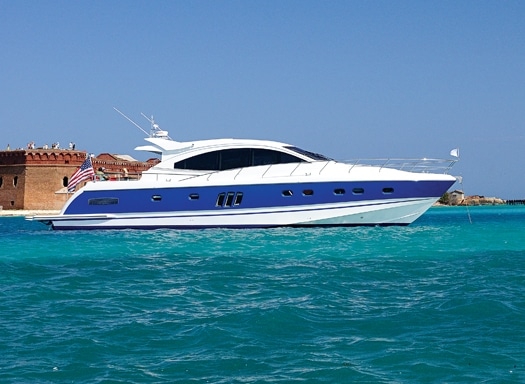
ytgmay09newport525.jpg
Read any cruising guide about the Dry Tortugas, the low-lying islands 70 miles west of Key West, and you’ll understand why you’ll want to have a contingency plan for staying longer than anticipated. Unpredictable weather can keep you hunkered down in a protected anchorage for days. The offshore passage can be challenging, especially during the winter, when cold fronts frequently stall over this part of the Gulf of Mexico.
Once you get out there, you need to be totally self-sufficient. There’s no water. No food. And no fuel. Just thousands of screeching birds, a few friendly park rangers, and a massive, historic fort.
When you see the clarity and color of the water, the pristine beaches, the fun, educational tours and, most importantly, the total absence of commercialism, you may use your contingency plan and stick around- regardless of the weather. But a visit is worth the risk of a rough ride.
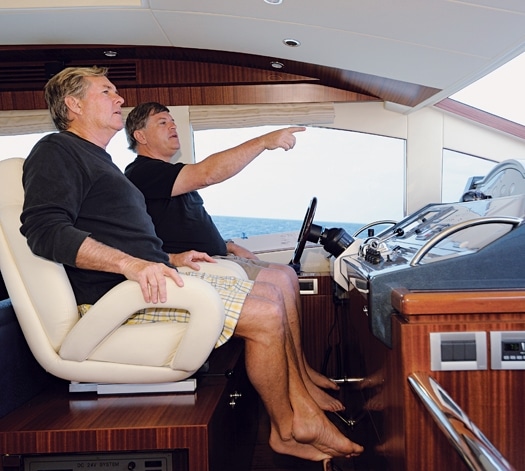
| | |
My ride was a far cry from roughing it. I was joining Trey Beasley, part owner of AGYG, the yacht-development company behind the line of Newport Yachts, aboard the company’s luxurious, high-performance Newport 71. AGYG also brings the classic-looking Outer Reef series to market. Beasley wanted to give this all-new model a proper shakedown and demonstrate the performance of its quad Volvo Penta IPS drives.
Joining us was Trey’s wife, Jan, and their friends Pat Segraves and Denise Reed from Palm Beach. Our plan was to meet in Key West and run out to the Dry Tortugas for an overnight visit. While at first this seemed a bit hurried, I easily adjusted to the compressed schedule of cruising at 27 knots. We would leave Key West early in the morning and be at our anchorage in Garden Key, home of Fort Jefferson, in two and a half hours. This would give us all day to explore the fort, enjoy a sunset dinner on deck, watch a late-night movie, have an early breakfast the next morning and be back in Key West for lunch.
It was easy finding the Newport 71 in the Galleon Marina in Old Town, Key West, even without knowing its slip number. Its royal blue and white hull has distinctive lines and stood out from all the white-on-white sportfishermen and express boats. All boats have a look that matches their personality, and from the outside, the Newport 71 looks fast even when tied to the dock. Entering the main salon, its full personality is revealed- this is a superbly finished contemporary yacht that delivers a real wow.
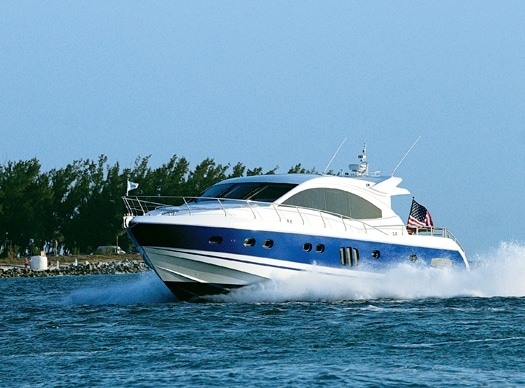
| | |
While Beasley was anxious to show off the yacht’s accommodations, I wanted to find out more about its unconventional propulsion system. I headed for the engineroom located below the aft deck to see just how they arranged the four 435-horsepower Volvo diesel engines. There they were, fit snugly side by side, with the two inboard engines slightly lower than the two outboard ones. This impressive display of power was made a bit sexier by the blue, indirect LED lighting beneath each engine. There is enough room to service each powerplant, although the presence of an optional water toy garage, which sits above the two inboard engines, limits headroom. Access to the engineroom is from the aft deck, down a ladder and through nicely finished crew’s quarters.
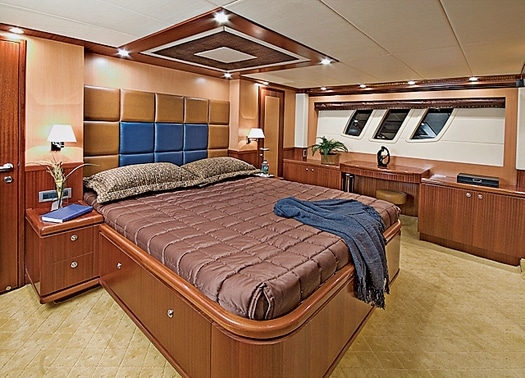
| | |
Before sunrise the next morning, I was wakened by my iPhone alarm, and not by the usual sound of engines being started. All four Volvos were, in fact, warming up, but from my stateroom there was only a hint of quadraphonic murmur. While Segraves and I handled dock lines, Beasley calmly stood at the aft control station with just two fingers on the joystick, confidently maneuvering this $3-plus million, 74,000-pound vessel out of a tight slip. The quad IPS drives did their magic, executing a perfect exit accompanied by a swirling, bubbling rush of water beneath our hull.
Clear of Key West’s no-wake zone, we throttled up to 3150 rpm and quickly reached our cruising speed of 26.5 knots. In the two-foot chop, the loudest sound was from the head seas slapping the forward sections of the go-fast hull-not from engine noise. The hull sound became more pronounced the farther forward I moved, but with the windows closed and the air conditioning running, it was possible to have a quiet conversation sitting on the settee located directly above those 1,740 horses-an impressive display of quiet power.
Our 70-mile run out to the Dry Tortugas was straightforward and uneventful with our route taking us south of the Marquesas, a number of small keys with a couple of protected anchorages. Further west we passed Rebecca Shoals, an area notorious for its rough seas due to the meeting of the two Gulf Streams. But our weather was ideal, and soon we were heading up the Southeast Channel, clearing Iowa Rock and entering the well-marked channel to the west of Garden Key. We dropped anchor in front of Fort Jefferson just off the shores of Bush Key, home to thousands of noisy sooty terns and off limits to visitors.
The anchorage has room for dozens of boats, and the National Park Service provides beach space for dinghy landings. Within minutes of our arrival, two large, high-speed catamaran ferries from Key West landed dozens of visitors who embarked for organized tours of the fort. The Beasleys had been here before and served as our personal guides.
Construction of the massive Fort Jefferson began in 1846 and despite 30 years of work, it was never fully completed. Originally designed as an advance post for an American defense of the Gulf Coast, it was to deploy 420 heavy guns and house over 2,000 civilians and military personnel. Problems with a faulty foundation, corrosive salt air, and repeated epidemics of malaria and yellow fever created constant delays.
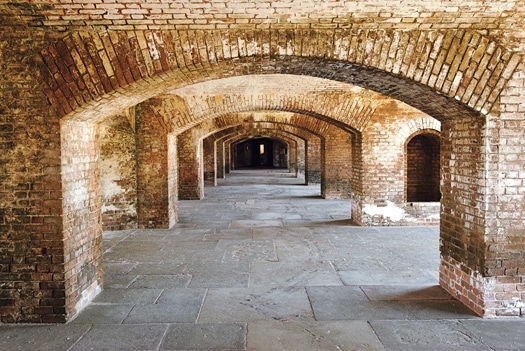
| | |
Beginning in the 1860s, the fort was used as a federal prison for military deserters and civilian convicts, and its most notorious prisoner, Dr. Samuel Mudd, arrived in 1865. Mudd, who was convicted of conspiracy in the assassination of President Lincoln, redeemed himself by providing much-needed medical care for the fort’s population during the yellow fever epidemic of 1867. He was eventually pardoned by President Andrew Johnson and released. Mudd’s cell has been preserved, a reminder of his bleak time here. The Army abandoned the fort in 1874.
In 1992, the Dry Tortugas was designated a National Park, and today it hosts 80,000 visitors annually who come here to snorkel, fish, and birdwatch. Fishing must be done outside the park limits. There are about a dozen primitive campsites on Garden Key, and all campers must bring their own food and water. No trash can be left behind. Heads are available near the dock, but they do not have sinks or showers. A visitor’s center in the fort offers a bookstore and a video presentation. A major, multiyear effort is underway to preserve the ever-crumbling fort.
Following an afternoon of exploring the fort, we retired to the comfort of the 71 to enjoy a sunset dinner and late-night movie. The Newport’s “cathedral” galley is located below the main salon, but it is open to the main living area. This arrangement allows those preparing meals to stay connected to the social activity in the salon, while keeping the sights and sounds of food preparation contained in the galley.
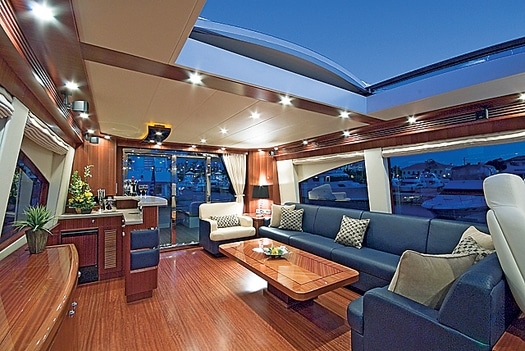
| | |
In the main salon, an expansive, L-shaped settee and comfortable lounge chairs surround a large cocktail table, creating a social center that can accommodate a small crowd. The yacht’s wide panoramic windows, aft glass door and see-through bulkhead provided 360-degree views of the beautiful anchorage. When weather permits, a large electric sunroof transforms the salon into an open-air space with a sky view.
The next morning we weighed anchor and headed back to Key West. Seas were running two to three feet, and we ran at various speeds to evaluate the performance and fuel efficiency of the four Volvos. If long distance and low fuel consumption are the main objectives, 1000 rpm will achieve a speed of 7.1 knots, burning just 3.2 gallons per hour. That’s total, not per engine. At 1500 rpm we ran at 9.5 knots, burning 8.8 gph. These numbers compare well with twin-engine vessels of similar size.
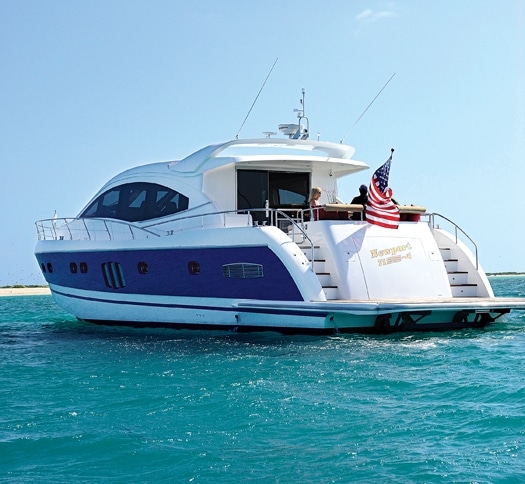
| | |
Running more than 9.5 knots but less than the vessel’s planning speed of 17.5 knots proved wasteful. Like all planing hulls, it pushes water out of its way, rather than getting on top. But once on plane, the Newport 71 is an agile athlete. At 2500 rpm she planes at 17.5 knots and burns 44 gph total. While her high cruise is 26.5 knots, she seems to have a sweet spot at 23.5 knots, burning 60 gph total. This translates to 0.4 nautical miles per gallon, a number that suggests that running four 435-horsepower Volvos configured with the IPS drives is as efficient, if not more, as running two higher-power engines with a conventional drive shaft system.
The subject of multiple IPS invariably leads to a question: Can shutting down one or more engines increase efficiency? “First of all, it is okay to run with one or more of the engines shut down,” says Kent Lundgren of Volvo Penta. “No damage will be done but our preliminary tests show no substantial fuel savings are achieved by running with one or more engines shut down.” A certain amount of horsepower is required to run a boat at a specific speed, and while fuel efficiency may be increased by running fewer engines to achieve that horsepower, that efficiency is negated by the drag of the nonworking drives.
What about higher maintenance costs? “Comparing our own engines, we’ve determined that maintaining four smaller engines rather than two larger engines often costs less money,” says Lundgren. “And if one engine on a twin-engine vessel quits, you lose maneuverability and a good percentage of your speed. But if one of the four IPS drives quits, you can maintain a decent cruising speed and still maneuver at a dock.”
We arrived back in Key West at lunchtime, and after a short visit to the fuel dock, Beasley single-handedly backed the 71 into a narrow slip alongside a menacing pile of rocks that serves as the marina’s breakwater. The quad IPS-powered Newport 71 showed us how new technology can simplify a captain’s life, improve efficiency, and enhance the boating experience. And if you happen to find yourself in a pristine anchorage with turquoise waters and fascinating fauna, maybe you had better think about using your contingency plan, and staying a bit longer.
AGYG, (954) 767-8305; **www.agyg.com**








